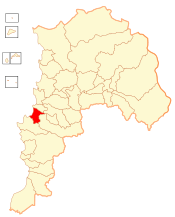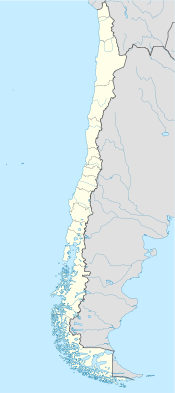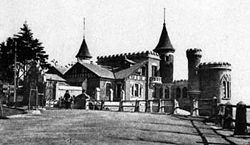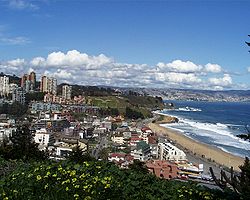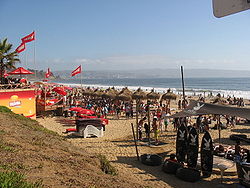- Viña del Mar
-
Viña del Mar — City and Commune — The Clock of Viña del Mar, on March 1, 2011. 
Flag
Coat of armsNickname(s): Ciudad Jardín (Garden City) Map of the Viña del Mar commune in Valparaíso Region Location in Chile Coordinates (city): 33°0′S 71°31′W / 33°S 71.517°WCoordinates: 33°0′S 71°31′W / 33°S 71.517°W Country Chile Region Valparaíso Province Valparaíso Viña del Mar May 31, 1878 Government[1] – Type Municipality – Alcalde Virginia Reginato Bozzo (UDI) Area[2] – Total 121.6 km2 (47 sq mi) Population (2002 Census)[2] – Total 286,931 – Density 2,359.6/km2 (6,111.4/sq mi) – Urban 286,931 – Rural 0 Sex[2] – Men 136,318 – Women 150,613 Time zone CLT[3] (UTC-4) – Summer (DST) CLST[4] (UTC) Website Municipality of Viña del Mar Viña del Mar (Spanish pronunciation: [ˈbiɲa ðel maɾ] meaning "Vineyard by the Sea"), is a city and commune on central Chile's Pacific coast. Its long stretches of white sandy beaches are a major attraction for national and international tourists. The city is Chile's main tourist attraction. Known as "La Ciudad Jardín" ("The Garden City"), Viña del Mar is a Chilean Municipality located in the Valparaíso Region. Viña del Mar has a population of 286,931 (according to the 2002 census), it is Chile's fourth largest city. Viña del Mar is part of the Greater Valparaíso area, the country's third largest metropolitan area (pop. 803,683, 2002 census), after the Metropolitan areas of Santiago and Concepción. The Greater Valparaíso Area is home to 5 municipalities: Valparaíso, Viña del Mar, Concon, Quilpue, and Villa Alemana.[5]
Viña del Mar is best known as a tourist and beach resort destination, its white sanded beaches include "the be seen" Reñaca Beach, Las Salinas Beach. A major attraction is its Viña del Mar Municipal Casino founded in 1930, it is one the oldest gambling establishments in South America. Each Summer in late February, the town hosts its Viña del Mar International Song Festival. The Festival ground is nestled in the striking natural tree lined hill of Quinta Vergara Amphitheater. Another major attraction is the Viña del Mar Film Festival, founded in 1967 as the First Latin American Film Festival and was also the first gathering of Latin American filmmakers. Organized by the Municipal Government of Viña del Mar FICVIÑA, the 2010 Festival awarded its coveted Paoa First Prize to the Colombian film “Retratos de un mar de mentiras” directed by Carlos Gaviria.
Contents
History
The valley where Viña del Mar was founded was known as the valley of Peuco by the Changos, native inhabitants of the area dedicated to fishing. With the arrival of the Spanish conquistadores the valley was divided into two large haciendas. North of the Marga Marga creek up to the current location of Reñaca, Viña del Mar, and to the south up to the current Cerro Barón (Baron Hill), the Hacienda Las Siete Hermanas (The Seven Sisters).
Francisco Javier Álvarez authorized the construction of a railroad through his lands to join Santiago and the port of Valparaíso. The arrival of the railroad brought a young engineer Jose Francisco Vergara who married Francisco Javier Álvarez’s granddaughter, Mercedes Álvarez. It was José Francisco Vergara who instigated the idea of the creation of a new city independent of Valparaíso. Finally on May 30, 1878, the Chilean government authorized the creation of the new city of Viña del Mar.[citation needed]
In 1892, Salvador Vergara (son of José Francisco Vergara) commenced the development of the north bank of the Marga Marga creek under the name of Población Vergara, around the current Avenida Libertad (Liberty Avenue).
The establishment of Refinadora de Azúcar de Viña del Mar (Sugar Refining Company), CRAV in 1873 and the arrival of the British company of Lever & Murphy in 1883 gave the necessary economic push to transform the young city into one of the most important cities of Chile. The building of a military installation, Regimiento Coraceros in 1917, naval facilities in Las Salinas, and the housing of military and naval personnel furthered the city's growth. That year, what had been so far a beautiful house by the sea shore became, after some rehabilitation, what is known today as Wulff Castle.[6]
In 1925, the Teatro Municipal was opened in its current location in the eastern front of the city's downtown square, Plaza de Viña del Mar. In 1928 president Carlos Ibáñez del Campo authorized the creation of a casino, securing the future and the touristic character of the city. The Casino Municipal de Viña del Mar was opened on December 31, 1930. On January 31, 1931, the Presidential Palace was inaugurated in Cerro Castillo (Castle Hill) as a summer residence for the Chilean President. The touristic character of the city was furthered with the inauguration of the O'Higgins Hotel in 1936 and the inauguration of the Miramar Hotel by Caleta Abarca Beach in 1945. Later a number of small industries settled in the eastern part of the city, bordering the Marga Marga creek in El Salto, including a Coca-Cola bottling facility, meat processing facilities, and chemical factories.[citation needed] For a few years in the early 1960s, a trolleybus line connected the city with Valparaíso, and the electric route network included three branches within Viña.[7]
Viña del Mar was one of the four host cities of the 1962 football (soccer) World Cup. It is now home to CD Everton, a soccer team in the Chilean Premier division, which took its name from the English team.
Viña del Mar was declared a sister city of Sausalito, California (a city north of San Francisco), in 1971. To demonstrate the sister city relationship, you can find a square (plaza) called "Viña del Mar" in downtown Sausalito, and a "Sausalito" stadium and "Sausalito" lagoon in Viña del Mar. Viña del Mar is also a sister city of Mar del Plata, Argentina since 1993.[citation needed]
During the 1980s, a global economic downturn seriously affected the city, a number of small and medium sized factories went bankrupt, including the stationery manufacturer Coda, and most importantly, CRAV, and Textiles Viña, two of the biggest employers in the city. Unemployment rose to alarmingly high rates. Many factories started to consolidate their operations in Santiago making the situation even worse. The city has failed to fully recover from the blows inflicted by the economic downturn of 1982, but an increase in the number of international tourists visiting the city, and the recent high prices of copper in world markets have promoted an economic recovery.[citation needed]
Extensive commercial redevelopment in the 15 Norte Avenue area, previously an abandoned industrial area, has seen most of the large Chilean retail chains settling in the area, which is now covered with large shopping malls, like Marina Arauco, cinemas, fast food stores, and supermarkets.
The city has benefitted from major investments in infrastructure that have greatly improved the traffic flow in the downtown area,[citation needed] especially in routes connecting Viña del Mar with Santiago, Valparaíso and Quilpué. A modern and efficient subway (Merval) connects Viña del Mar with the cities of Limache and Valparaíso, following the original railroad tracks between Valparaíso and Santiago.
The city was affected by the February 27, 2010 earthquake.[8]
City landmarks
Visitors and locals enjoy the parks and water fountains of the city, including a large flower clock (Reloj de Flores) with its numbers made up of flowering plants, near Caleta Abarca beach. The Valparaiso Sporting Club horse racing track is another major landmark. Jardín Botánico or Parque del Salitre, a rather large botanical garden on the outskirts of the city, was originally designed and built by an entrepreneur who got rich from exploiting saltpeter resources in northern Chile.
A few buildings from the 19th century still remain after multiple earthquakes that have destroyed most of the old areas of the city. Most of the older buildings that remain are located along Avenida Libertad (Liberty Avenue), Quillota Street and Quinta Vergara, a rather large park in the middle of the city. The presidential summer residence, Castillo Presidencial (Presidential Castle) is located on Cerro Castillo (Castle Hill).
The city's casino was designed with art deco style and is surrounded by well-tended gardens (hence the city's nickname). In 2002 a hotel (Hotel del Mar) was added to the 1930s building, resembling the architectural features of the original building.
Palacio Rioja, a mansion built by Fernando Rioja in 1907, located on Quillota Street, houses an environmental museum. The Fonck Museum, located in Cuatro Norte Street, has a large exhibition of pre-Columbian articles, and a large moai (Easter Island statue made of volcanic rock), the only one in mainland Chile, is also on display. Palacio Carrasco, built by Emilio Carrasco in 1912, now houses the Municipal Library and also is used for arts exhibitions. The building is also surrounded by nice gardens adorned with fine sculptures including a Rodin. Palacio Vergara located in Quinta Vergara was built by Blanca Vergara (daughter of José Francisco) in 1906 and it is now owned by the municipality. It currently houses the School of Fine Arts and has produced important Chilean artists like the painter Giancarlo Bertini.
Palacio Brunet (also known as "Castillo Yarur") was built in 1923 by Adolfo Brunet on Cerro Castillo, close to the presidential mansion. Currently it is owned by Carabineros de Chile (Chilean police) and is used as a reception center for important visitors. It was declared a national monument in 2005.
Palacio Carrasco and its surrounding park, located on Liberty Avenue #250, between 3 and 4 Norte, was completed in 1923. For years it was a private residence until it moved to the Municipality of Viña del Mar. After moving it to its current location in Arlegui street, the Palacio Carrasco became a Library Benjamín Vicuña Mackenna, public library of the commune, while working as center for events, art exhibitions, and cultural workshops. It is very important to stress that the building is totally unsuitable for use as a public library and the community needs to build a new recint for this purpose. Outside the entrance to the Palacio Carrasco there a sculpture by Auguste Rodin called "La Defensa". It was declared a National Historic Monument on September 8, 1986 under Supreme Decree No. 791.
Castillo Wulff, iconic building of the commune, of neo-Tudor style, built in 1906. Strategically located in the coastal border between the mouth of Marga Marga and Caleta Abarca (Avenida Marina N° 37). Was built by Don Gustavo Wulff Mowle (1862–1946) businessman and philanthropist of Valparaíso. The building was designed in two floors connected to a torreón through a medieval-style bridge. In 1995 it was declared a national monument, but today houses the offices of the headquarters of the Heritage Unit of the Municipality of Viña del Mar.
Culture
Numerous bars and restaurants have recently opened in the area around Plaza México and Avenida San Martín, offering Chilean an international cuisine. Seafood restaurants are located on the Camino Costero (Coast Roadway) that joins Viña del Mar and Con-Cón, a coastal town to the north.
The Yacht Club de Chile is a yacht club located in Caleta Higuerilla. This club was established in Viña del Mar in 1955.
Artequin Museum of Viña del Mar, located in the Parque Potrerillos in Viña del Mar, this newly opened museum has as mission to bring children and youths from the region for the Visual Arts in an entertaining way.
The Viña del Mar International Film Festival is considered within the most important film festivals in Chile and Latin America.
Another important event is the Viña del Mar International Song Festival, held at the amphitheater located in the Quinta Vergara, one of the largest green areas of the city. The amphitheater of the Quinta Vergara was built in the 1960s. Viña del Mar International Song Festival has featured a diverse range of bands and has helped expose and popularize artists.
There is also the Palacio Vergara, with a major museum. The trees placed around are of various exotic species introduced there in the 19th century when was still the Hacienda de las Siete Hermanas, to the delight of their owners.
The Municipal Theatre of Viña del Mar, located in front of Plaza de Viña, is a center of cultural and artistic events of first importance in Chile. In the neighboring block is also the traditional and elegant Club de Viña, with a classical facade.
The Museum of Naval Canyons is an outdoor museum, located on the road Jorge Montt (connecting Viña del Mar with the beaches of Las Salinas with Reñaca), whose beach is exhibiting several pieces of artillery, in front of the facilities of the Chilean Navy.
The Fonk Museum, located at 4 Norte, is a museum which exhibits archaeological objects of Chile, mainly from Easter Island and Mapuche culture.
New Year
Viña del Mar is known as one of the big points, which also offers a wide panorama, to celebrate the New Year. The fame that panders to the city is, among many things, its big show with fireworks and the alliance it had with the neighboring town of Valparaíso, who has extensive experience with fireworks at the end of the year, it can be seen from many points along the coast, and the hills too. The fireworks are launched from platforms that are located in various parts of the bay, in a coordinated way. To receive the 2007 Viña made a millionaire investment who did not disappoint any viewer. It is also important to highlight that this show was an extension of 27 kilometers. With this, Viña del Mar, along with Valparaíso and Concón, postulated to the Guinness World Records.
Climate
Viña del Mar has a warm-summer Mediterranean climate with coastal influence of the Humboldt Current. In January minimum temperatures range between 59 °F (15 °C) and 64 °F (18 °C) while in July vary between 48 °F (9 °C) and 55 °F (14 °C). The rain falls mainly in autumn and winter, with July being the rainiest (107 mm). The average annual rainfall totals 480 mm.
Climate data for Viña Del Mar Month Jan Feb Mar Apr May Jun Jul Aug Sep Oct Nov Dec Year Average high °C (°F) 24.4
(75.2)23.1
(73.4)22.3
(71.6)20.2
(66.2)18.3
(64.4)17.0
(62.6)15.4
(59.0)15.9
(60.8)17.6
(62.6)19.5
(66.2)21.5
(69.8)23.1
(73.4)19.9
(66.2)Average low °C (°F) 15.6
(59.0)15.4
(60.2)15.8
(61.3)14.1
(57.2)13.4
(55.4)12.1
(53.6)10.6
(50.0)11.2
(52.2)13.3
(55.3)13.9
(57.2)15.0
(59.0)15.6
(59.3)13.0
(55.1)Precipitation mm (inches) 5
(0.2)4
(0.16)14
(0.55)30
(1.18)50
(1.97)100
(3.94)107
(4.21)75
(2.95)40
(1.57)25
(0.98)20
(0.79)10
(0.39)480
(18.9)Source: [9] Education
Several superior educational institutions (universities), both public and private, are located in Viña del Mar:
-Pontificia Universidad Católica de Valparaíso with its Architecture (Recreo), Arts (Miraflores), Philosophy and Education (Sausalito) and History (Alvarez Avenue) campus
-Universidad de Valparaíso has Business and Administration, Marine Sciences and Engineering faculties
-Universidad Tecnica Federico Santa Maria located in the limit between Valparaiso and Viña del Mar (España avenue).
-Universidad de Viña del Mar located in Rodelillo.
-Universidad Andrés Bello
-Universidad del Mar
-Universidad de las Américas located above the city Mall
-Universidad Adolfo Ibañez
Plus a vast offer in tecnical education institutions.
The Chilean Navy also operates several technical schools and a planetarium in Las Salinas, at the northwest edge of the city.[citation needed], for the education of it`s especiality students.
Demographics
According to the 2002 census of the National Statistics Institute, Viña del Mar had 286,931 inhabitants (136,318 men and 150,613 women), making the commune an entirely urban area. The population grew by 0.5% (1,477 persons) between the 1992 and 2002 censuses. Viña del Mar accounts for 18.63% of the regional population.[2]
Notable residents
The city is the birth place of Alberto Hurtado, the second Chilean Catholic saint and founder of the Hogar de Cristo (Home of Christ) foundation, writer Maria Luisa Bombal, the author of La Ultima Niebla (The Last Fog), former Chilean president Patricio Aylwin, handball player Marco Oneto tennis player Nicolás Massú and Slayer vocalist/bassist, Tom Araya.
Administration
As a municipality, Viña del Mar is a third-level administrative division of Chile governed by a municipal council, headed by an alcalde (mayor) who is elected every four years. For the period of 2008–2012 the Mayor is Virginia Reginato Bozzo of far-right (UDI). The Municipal Council has the following members:[1]
- Eugenia Garrido Alvarez de la Rivera (UDI)
- Laura Giannici Natoli (DC)
- Pamela Hödar Alba (UDI)
- Macarena Urenda Salamanca (UDI)
- Jaime Varas Valenzuela (UDI)
- Victor F. Andaur Golmes (PC)
- Andrés Celis Montt (RN)
- Tomás de Rementeria Durand (PPD)
- Rodrigo Kopaitic Valverde (RN)
- Felicindo Tapia Tassara (PR)
The regional intendant, appointed by the president, is Raúl Celis Montt.[10]
In Congress, Viña del Mar in the Chamber of Deputies belongs to the 14th electoral district, while for the Senate it is part of the 6th Senatorial Valparaíso Coast District. In the Chamber of Deputies it is represented for the 2010–2014 period by Mr. Edmundo Eluchans of far-right (UDI) and Mr. Rodrigo González of centre-left (PPD). In the Senate the elected Senators representing Viña del Mar for an 8-year term (2010–2018) are Francisco Chahuán Chahuán of rightist (RN) and Ricardo Lagos Weber centre-left (PPD).
References
- ^ a b (Spanish) "Municipality of Viña del Mar". http://www.munivina.cl/. Retrieved November 15, 2010.
- ^ a b c d (Spanish) "National Statistics Institute". http://www.ine.cl/canales/chile_estadistico/censos_poblacion_vivienda/censo_pobl_vivi.php. Retrieved August 10, 2010.
- ^ "Chile Time". WorldTimeZones.org. http://www.world-time-zones.org/zones/chile-time.htm. Retrieved July 26, 2010.
- ^ "Chile Summer Time". WorldTimeZones.org. http://www.world-time-zones.org/zones/chile-summer-time.htm. Retrieved July 26, 2010.
- ^ Chile: Ciudades, Pueblos, Aldeas y Caseríos 2005, Instituto Nacional de Estadísticas – June 2005.
- ^ http://www.patrimoniovina.cl/index.php?ir=pags/det_nuestracasa.php paragraphs under Historia. Spanish only
- ^ The Trolleybuses of Valparaíso, Chile (detailed history). Allen Morrison. 2006. Retrieved 2011-03-14.
- ^ (French) Easy Voyage, "Le Chili 5 jours après le séisme", March 4, 2010 (accessed March 4, 2010)
- ^ "Viña del mar, Chile". Australian Bureau of Meteorology. May 2011. http://weather.msn.com/local.aspx?wealocations=wc:CIXX0027&q=Viña+del+Mar,+CHL. Retrieved March 23, 2009.
- ^ (Spanish) "Gobierno de Chile: Intendentes". http://www.gobiernodechile.cl/intendentes/. Retrieved November 15, 2010.
External links
- (Spanish) Municipality of Viña del Mar
- (Spanish) Viña del Mar commercial guide
- Plaza Viña del Mar at Sausalito, California
- Municipality of Viña del Mar
Greater Valparaíso Cities Universities Pontifical Catholic University of Valparaíso · Federico Santa María Technical University · University of Valparaíso · University of Educational Sciences "Playa Ancha"Culture and sports El Mercurio de Valparaíso newspaper · Everton de Viña del Mar Football Club · Santiago Wanderers Football Club · Trolleybuses in Valparaíso (national monument)Chilean cities with a population of over 150,000 (2002) Greater Santiago (Puente Alto, Maipú, La Florida, Las Condes, San Bernardo, Peñalolén, Santiago, Pudahuel, La Pintana, El Bosque, Ñuñoa) · Greater Valparaíso (Valparaíso, Viña del Mar) · Greater Concepción (Concepción, Talcahuano) · Greater La Serena (La Serena, Coquimbo) · Antofagasta · Greater Temuco · Greater Rancagua · Greater Talca · Arica · Greater Chillán · Copiapó · Iquique · Osorno · Puerto Montt
Categories:- Populated places in Valparaíso Province
- Communes of Chile
- Populated places established in 1878
Wikimedia Foundation. 2010.


